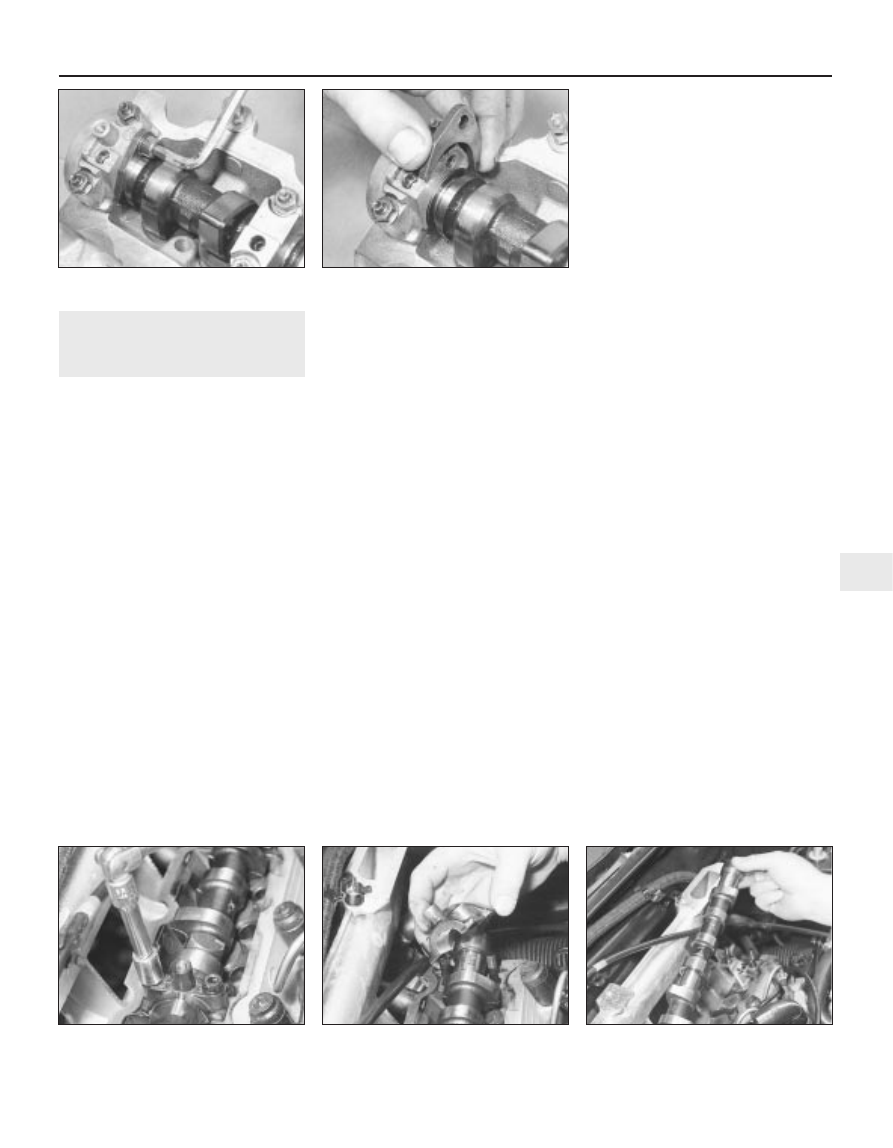содержание .. 8 9 10 11 ..
Peugeot 205. Manual - part 10

7
Camshaft and followers -
removal, inspection and
refitting
4
Removal
1 Remove the camshaft sprocket as
described in Section 5. Remove the rear cover
plate behind the sprocket.
2 Remove the camshaft cover. For ease of
access, remove the distributor cap and HT
leads, air cleaner assembly and brake servo
vacuum hose.
3 Remove the distributor as described in
Chapter 5B.
4 Carefully ease the oil supply pipe out from
the top of the camshaft bearing caps, and
remove it. Note the O-ring seals fitted to each
of the pipe unions on later models.
5 Where fitted undo the bolt and remove the
camshaft thrust plate (see illustrations).
6 The camshaft bearing caps should be
numbered 1 to 5, number 1 being at the
transmission end of the engine. If not, make
identification marks on the caps, using white
paint or a suitable marker pen. Also mark
each cap in some way to indicate its correct
fitted orientation. This will avoid the possibility
of installing the caps the wrong way around
on refitting.
7 Evenly and progressively slacken the
camshaft bearing cap retaining nuts by one
turn at a time. This will relieve the valve spring
pressure on the bearing caps gradually and
evenly. Once the pressure has been relieved,
the nuts can be fully unscrewed and removed
(see illustration).
8 Note the correct fitted orientation of the
bearing caps, then remove them from the
cylinder head (see illustration).
9 Lift the camshaft away from the cylinder
head, and slide the oil seal off the camshaft
end (see illustration).
10 Obtain eight small, clean plastic
containers, and number them 1 to 8;
alternatively, divide a larger container into
eight compartments. Using a rubber sucker,
withdraw each follower in turn, and place it in
its respective container. Do not interchange
the cam followers, or the rate of wear will be
much-increased. If necessary, also remove
the shim from the top of the valve stem, and
store it with its respective follower. Note that
the shim may stick to the inside of the follower
as it is withdrawn. If this happens, take care
not to allow it to drop out as the follower is
removed.
Inspection
11 Examine the camshaft bearing surfaces
and cam lobes for signs of wear ridges and
scoring. Renew the camshaft if any of these
conditions are apparent. Examine the
condition of the bearing surfaces, both on the
camshaft journals and in the cylinder
head/bearing caps. If the head bearing
surfaces are worn excessively, the cylinder
head will need to be renewed.
12 Examine the cam follower bearing
surfaces which contact the camshaft lobes for
wear ridges and scoring. Renew any follower
on which these conditions are apparent. If a
follower bearing surface is badly scored, also
examine the corresponding lobe on the
camshaft for wear, as it is likely that both will
be worn. Renew worn components as
necessary.
Refitting
13 Where removed, refit each shim to the top
of its original valve stem. Do not interchange
the shims, as this will upset the valve
clearances (see Section 2).
14 Liberally oil the cylinder head cam
follower bores and the followers. Carefully
refit the followers to the cylinder head,
ensuring that each follower is refitted to its
original bore. Some care will be required to
enter the followers squarely into their bores.
15 Liberally oil the camshaft bearings and
lobes, then refit the camshaft to the cylinder
head. Temporarily refit the sprocket to the end
of the shaft, and position it so that the
sprocket timing hole is aligned with the
corresponding cut-out in the cylinder head.
Also ensure that the crankshaft is still locked
in the timing position (see Section 4).
16 Ensure that the bearing cap and head
mating surfaces are completely clean,
unmarked, and free from oil. Refit all the caps,
using the identification marks noted on
removal to ensure that each is installed
correctly and in its original location.
17 Evenly and progressively tighten the
camshaft bearing cap nuts by one turn at a
time until the caps touch the cylinder head.
Then go round again and tighten all the nuts
to the specified torque setting. Work only as
described, to impose the pressure of the valve
springs gradually and evenly on the bearing
caps.
18 Where applicable, refit the camshaft
thrust plate and secure with its retaining bolt.
19 Examine the oil supply pipe union O-rings
(where fitted) for signs of damage or
deterioration, and renew as necessary. Apply
a smear of clean engine oil to the O-rings.
Ease the pipe into position in the top of the
bearing caps, taking great care not to
displace the O-rings.
20 Refit the distributor as described in
Chapter 5B.
XU series engine in-car repair procedures 2B•7
2B
7.5a Removing the camshaft thrust plate
bolt . . .
7.5b . . . followed by the thrust plate
7.7 Progressively unscrew the camshaft
bearing cap nuts . . .
7.8 . . . and remove the caps
7.9 Lift the camshaft from the cylinder
head